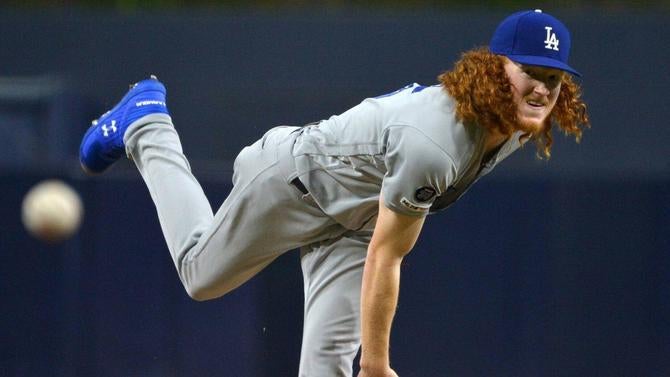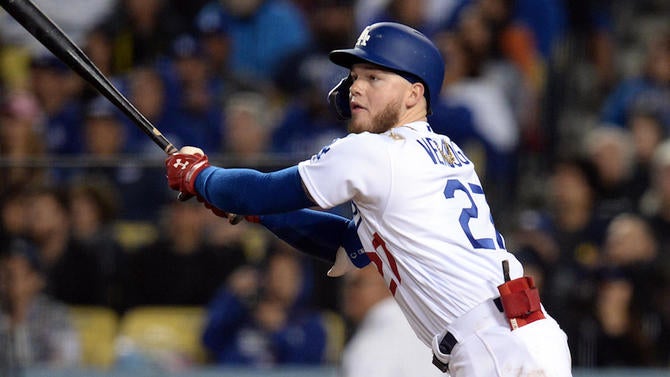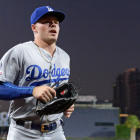Over the weekend, Los Angeles Dodgers president Stan Kasten discussed the team's payroll, fan discontent, and other topics with Los Angeles Times columnist Bill Plaschke. The most interesting part of Kasten's conversation with Plaschke was when he said he expects the Dodgers to exceed the luxury-tax threshold in 2020. As we noted on Monday, the Dodgers will need to add substantial payroll before season's end to cross over the tax line.
Because of the Dodgers' payroll flexibility and their repeated failures to win a World Series, they've been connected to nearly every star on the trading block -- be it Mookie Betts, Nolan Arenado, or Francisco Lindor. It stands to reason that the Dodgers will land one of them, or someone of equivalent standing, at some point between now and August 2020. Otherwise, the Dodgers will have wasted a golden opportunity to improve their championship chances.
Who might the Dodgers deal in order to fulfill their star quest? Let's take a look at their top trade chips. Note that the players are broken down into tiers:
top prospects (those who could realistically anchor a trade)
additional prospects of note (those who would fill out a package)
cost-controlled players (anyone with three years or less of big-league service time)
team-controlled players (anyone with more than three years but less than six years of service time)
everyone else who might attract interest in negotiations

Top prospects
Andrew Friedman has built a player evaluation and development machine in Los Angeles. Consider that the Dodgers' first pick in the 2016 draft came at No. 20. That didn't stop them from uncovering four players who'll be mentioned throughout this piece, including two of the top prospects (and asks) in baseball: infielder Gavin Lux and right-hander Dustin May.
Lux (drafted No. 20) spent most of last season in the upper-minors, where he hit .347/.421/.607 with 26 home runs. His big-league cameo wasn't as fruitful, but he showed power and speed to go with his keen eye at the dish. Should Lux remain with the Dodgers, he'll likely slot in at second base. Another team might believe more in his chances at playing shortstop, upping his value. Wherever he plays, his breadth of offensive skills makes him a potential star.
May (No. 101 in 2016) is one of the most recognizable players on the Dodgers due to his red locks. He threw 34 quality innings last season in the majors, recording more than six strikeouts per walk. May did that without having the feel for his trademark curveball, which he threw around 10 percent of the time. He's mastered a cutter in recent seasons, giving him three potential above-average or better pitches if he's able to rediscover his breaker. Given his polish, particularly as it pertains to his control, he has the chance to turn into a No. 2 starter.
Additional prospects of note
Unlike the Los Angeles Angels, who have two good prospects and then a system full of lottery tickets, the Dodgers have ample depth beyond the top dogs. The Dodgers are like a well-stocked kitchen: they can fulfill almost any desire held by their trading partner.
If the team wants an intriguing young catcher with everyday potential, the Dodgers can offer either Keibert Ruiz or Diego Cartaya. A two-way contributor at the hot corner? Pick between Miguel Vargas and first-round pick Kody Hoese. There's a short-term No. 4 starter, in Tony Gonsolin, and a long-term one, in Gerardo Carrillo, just name the timeline and the Dodgers can make it work. The Dodgers can throw in DJ Peters to appease a craving for a freak-show outfielder, and can even submit Josiah Gray or Jeter Downs if their trading partner wants a former Cincinnati Reds prospect more than anything else in the world, for some odd reason.
Almost all of those players were covered in our Dodgers' top five list earlier this offseason, and their presence in the "others" tier speaks to the quality of this system. Teams who have enjoyed the Dodgers' recent successes and have gone without high draft picks -- they haven't selected better than 20th since 2013 -- shouldn't have the means to assemble this kind of farm.

Cost-controlled players
We'll save you the ask: the Dodgers are not moving catcher Will Smith, who grades well as a framer and who homered 15 times and posted a 134 OPS+ over his first 54 big-league games. He's considered untouchable, or, at least, about as unlikely to be touched as Walker Buehler.
The Dodgers employ four other pre-arb players of note, beginning with left-hander Julio Urias and outfielder Alex Verdugo, two brand-name youngsters who offer value on the field at a cost off it. Urias was suspended 20 games last season for violating the league's domestic violence policy after witnesses saw him shove his partner to the ground. Verdugo's issues are comparatively trivial: he's had his makeup questioned to the extent that some teams have ruled him out as a potential acquisition (so they say, anyway).
Elsewhere, the Dodgers have Matt Beaty and Caleb Ferguson, both of whom could fill out a package as big-league-ready contributors. Beaty is a four-corners type who has a good feel for contact and profiles as a fine option versus right-handed pitching. Ferguson's fastball-curveball combo is good enough for high-leverage work, but his command might limit him to middle relief.
Team-controlled players
If the Dodgers do acquire a new infielder, they'll probably part with one of their incumbents -- be it shortstop Corey Seager or second baseman Max Muncy. Both have their pros and cons: Seager has been a four-plus win player when healthy, but has struggled with back issues; Muncy now has more than 1,000 plate appearances suggesting his breakout is real, though other teams who are less data-savvy might not get as much out of his glove at second base. Seager has two years of team control remaining while Muncy has three left.
Alternatively, Joc Pederson could be the one on the move if the Dodgers land an outfielder. He's an above-average hitter against righties who hits the ball hard and draws a fair amount of walks. Pederson has reduced his strikeout rate over the past few seasons, but has seen his value dip as he's been relegated to left field. He'll be a free agent after the 2020 campaign.
The Dodgers have four other players to touch on here. Chris Taylor and Enrique Hernandez can each play on the dirt or in the grass, depending on what's needed. Taylor had the better year of the two, but he contributed a lot of weak contact -- a concerning development for a hitter so prone to swinging and missing. Hernandez, like Pederson, will hit free agency after the year. Taylor, for his part, will remain under team control through the 2021 season.
In a sense, Ross Stripling is the pitching version of Taylor and Hernandez. He has split his career between the rotation and bullpen to the tune of 40/60 breakdown. Stripling doesn't throw hard (his fastball averaged 90.6 mph in 2019), but he pounds the zone and misses bats with a four-pitch mix. He's notched between 70 and 100 innings in three of his four tries. With three more seasons of team control left, some team could get mileage from him in a hybrid role -- think of him as a younger version of Jesse Chavez.
Catcher Austin Barnes is a good framer with a substandard arm and bat. He's a disciplined hitter, but he doesn't have enough success when he puts the ball in play to view him as more than a reserve. His mitt and defensive versatility should ensure he reaches free agency (after the 2022 season), and it's easy to see him lingering about at the end of various 26-player rosters.
Everyone else
Seeing as how the Dodgers are pursuing a World Series title, it seems unlikely they would trade any of their tenured veterans. We'll list Joe Kelly and A.J. Pollock here for posterity's sake.
Kelly had unimpressive season-long statistics in the first of a three-year pact. He did perform better in the second half, posting a 3.48 ERA and recording more than five strikeouts per walk. It's not a coincidence that he improved right as he switched from an uncharacteristically changeup-heavy approach to one that featured his curveball more prominently. By season's end, he was flipping his breaking ball more than half the time to good effect.
Pollock averaged 79 games and a 103 OPS+ in the three seasons prior to signing with the Dodgers (though, to be fair, that games played total is skewed by a mostly wasted 2016); he then appeared in 86 games and had a 108 OPS+ in his first year with L.A. He's by no means an albatross or anything, but teams probably won't line up to take on the $50 million-plus remaining on his contract -- not with the knowledge that players don't usually get healthier as they age.
The Dodgers have an elite big-league roster with few discernible holes, as well as a good farm system that features both impact and depth and a flexible payroll situation. There aren't many organizations who can match Los Angeles in those regards. It makes sense, then, that the Dodgers are being mentioned in relation to every star player: for one, it's smart business on the seller's part to invoke the Dodgers bogeyman; for another, the Dodgers will have to acquire an elite player to upgrade at some positions -- they're that good across the board.


















